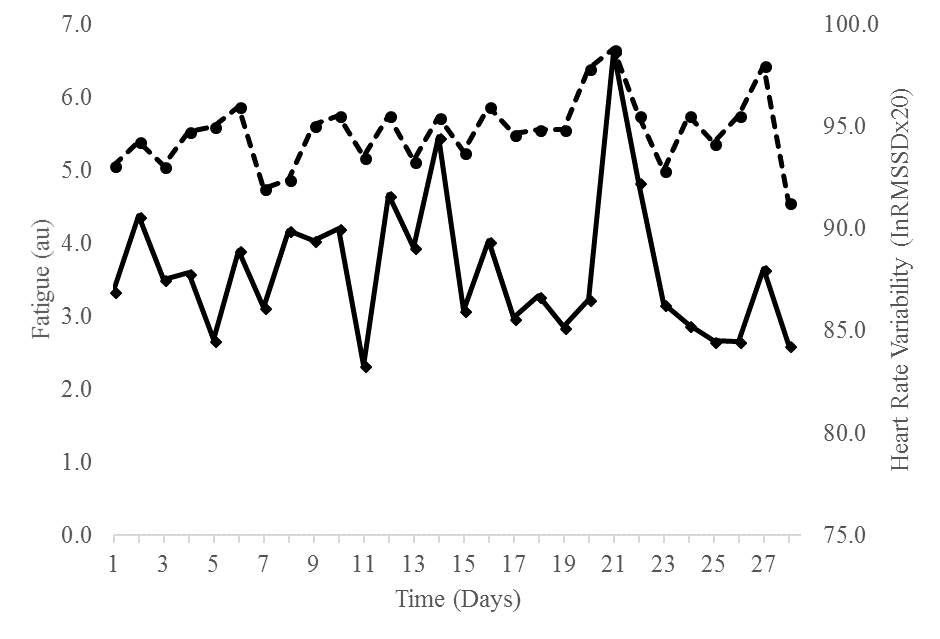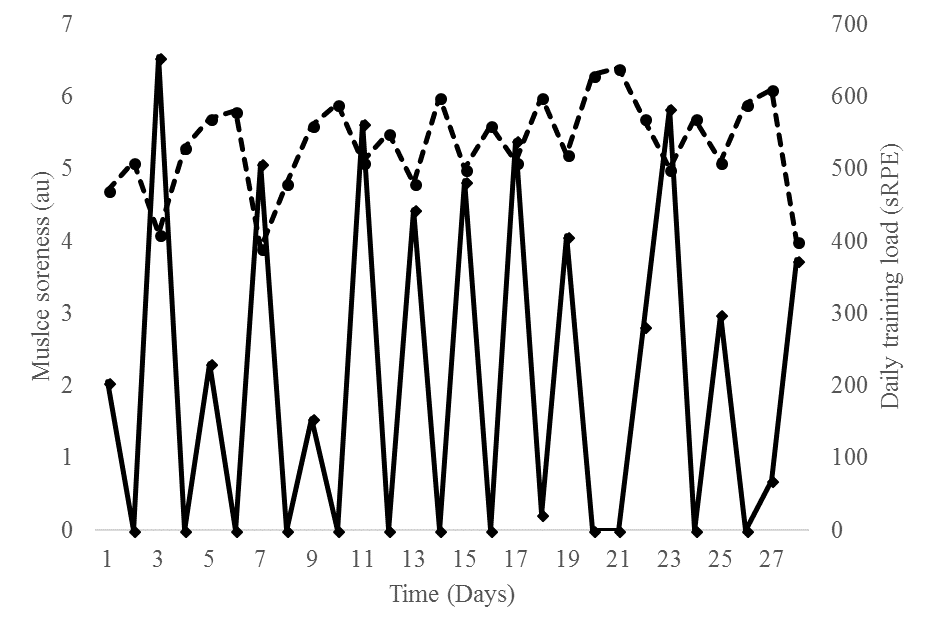 by Richard Beck
by Richard Beck
My name is Richard Beck and I am currently studying for a Masters in Strength & Conditioning from St Mary’s University, Twickenham. Over recent months I have been completing my dissertation, which used ithlete to monitor HRV. This is the final blog post in a three part series focusing on the results.
The Results
So, the results are in. Just a quick reminder about my study as it has been a while since my last post. I was looking at whether fluctuations in training load lead to changes in heart-rate variability in elite rugby union players. I had 16 professional rugby union players who took part in the 28-day study. They recorded their resting HRV and wellness scores every morning using the ithlete ECG receiver and smartphone application. Session rating of perceived exertion was used to quantify internal training load.

For the statistical analysis, a principal component analysis (PCA) was run initially which can combine common information from multiple measures whilst simultaneously separating unique information. This was a quite a cool analysis to run on the wellness variables and training load variables. Recent studies examining training load measures have used a similar data reduction process (Williams et al., 2017; Weaving et al., 2014; Weaving et al., 2018). After the PCA, a linear mixed model was run to examine the association between training load and HRV.
A total of 64 training weeks which consisted of 223 individual training days were completed by the players during the study. Figure 1 illustrates how HRV and Fatigue fluctuated across the length of the study. While Figure 2 illustrates how daily training load and muscle soreness fluctuated over the 28-day study. An increase in training load was typically followed by participants reporting increased muscle soreness the following day.

Figure 1. A line graph representing the daily group mean fatigue rating on the wellness questionnaire and the daily group mean heart rate variability (HRV) score across the length of the study. The black line represents daily group mean HRV values and the dashed line represents the daily group mean fatigue score on the wellness questionnaire (n = 16).

Figure 2. A line graph representing the daily group mean muscle soreness score on the wellness questionnaire and the group mean of the daily training load across the length of the study. The black line represents the mean of the groups daily training load and the dashed line represents daily group mean muscle soreness score on the wellness questionnaire (n =16).
The results of the linear mixed model describing the relationship between 3-day EWMA training loads, daily load and fatigue on HRV are displayed in Table 3. An increase in 3-day EWMA, daily load and fatigue were all associated with an almost certainly trivial change in HRV.
Table 3. Effects of wellness and training load measures on Heart Rate Variability (90%CI) (n=16)

CI, confidence interval
The aim of the current study was to investigate whether changes in daily training load led to changes in HRV. Contrary to the hypothesis, there was no dose-response relationship between changes in training load and HRV.
The PCA characterised 3 fundamental dimensions with one principal component for the wellness measures and two principal components for the training load measures. For the wellness measures, component 1 explained the largest proportion of variance (51%) and fatigue was selected as the representative measure for that principal component. For the training load measures, 3-day EWMA and daily load were selected as the representative measures for the two principal components. Component 1, which explained the largest proportion of variance (71%), was most associated with the 3 and 5-day EWMA. However, component 2 captured unique additional variance (21%) and so between them they explained 92% of total variance. The variables in this study may be unique to the current data set; however, this approach to monitoring and selecting a reduced number of wellness variables is a novel approach. This implies that coaches would not be missing out on information by only asking a player about one wellness variable rather than all six variables. This could save time for athletes and coaches as they would only have to report and interpret one variable rather than six
There could be a number of reasons why no relationship was found between training load and HRV. It could be the case that the training load in the current study was not enough to stress the cardiorespiratory system. Much of the previous research assessing the relationship between HRV and training load has collected data during pre-season or in endurance sports where training load tends to be higher. One of the closest studies to take into account rugby training demands is a study which used junior rugby league players as its participants which found HRV to fall the day following a match (Edmonds et al., 2013). However, there are some methodological concerns with this study in that there were only nine participants across 4-5 monitoring days and HRV recordings were taken in the afternoon prior to a training session. Nakamura et al. (2017) also conducted their study using rugby players who were participating in an intensive training camp and found lnRMSSD to fall in response to training load. The intensive nature of the 4-day training camp could be a reason why the authors found a relationship between HRV and training load. Again, the recordings were taken across only 4 days and were not taken immediately upon waking. In the current study, HRV was recorded immediately upon waking as this is thought to control for some of the environmental factors, such as noise, light and temperature, which the autonomic nervous system can be sensitive to while also being sensitive to training effects (Achten & Jeukendrup, 2003; Flatt & Esco, 2015).
A further reason for the contrast in findings could be due to the different participants used in the studies. The physiological demands of rugby union are very different to previous studies that used soccer and Australian rules football players as participants and so are likely to respond in a different way.
A limitation in the current study was the sample size used. Due to the relatively small sample size used it was not possible to look at each individual separately and assess the relationship between HRV and training load. Individuals had been accounted for anyway through the random intercept in the linear mixed model but there was not enough statistical power to assess each individual separately. It would be of benefit to look at individual data as there can be substantial intraindividual differences in response to the same training stimuli (Hedelin, Bjerle & Henriksson-Larsen, 2001). It may be the case that HRV is responsive to training load in some players and therefore a useful monitoring tool for some athletes but not others. A larger sample size would also have allowed for investigation into how different positional groups may affect the relationship between training load and HRV. It has been well reported that forwards in rugby union are involved in more contact occurrences and spend a larger proportion of match play above 90% of maximum heart rate than backs (Cunniffe, Proctor, Baker & Davies, 2009; McLellan, Coad, Marsh & Lieschke, 2013). It could be the case that due to these differences in training demands their fatigue response in terms of HRV is different to backs. Further research is required in this area to ascertain whether positional demands do play a role in HRV response.
In terms of practical applications for practitioners, it is worthwhile investigating whether multiple wellness and training load parameters are sharing a large proportion of information and whether they can be reduced into fewer variables. This is likely to be more time efficient for both the coach and the athlete. The current study has shown PCA as a useful process for practitioners to adapt. For example, practitioners could collect just ‘fatigue’ as their wellness parameter and daily load and 3-day EWMA as their training load variables rather than having to collect multiple variables. This process could be adapted in other sports settings in order to extract key measures and improve the fatigue monitoring process.

References
Achten, J., & Jeukendrup, A. E. (2003). Heart rate monitoring. Sports Medicine, 33(7), 517-538.
Cunniffe, B., Proctor, W., Baker, J. S., & Davies, B. (2009). An evaluation of the physiological demands of elite rugby union using global positioning system tracking software. The Journal of Strength and Conditioning Research, 23(4), 1195-1203.
Edmonds, R. C., Sinclair, W. H., & Leicht, A. S. (2013). Effect of a training week on heart rate variability in elite youth rugby league players. International Journal of Sports Medicine, 34, 1087-1092.
Flatt, A. A., & Esco, M. R. (2015). Smartphone-derived heart-rate variability and training load in a women’s soccer team. International Journal of Sports Physiology and Performance, 10(8), 994-1000.
Hedelin, R., Bjerle, P., & Henriksson-Larsen, K. (2001). Heart rate variability in athletes: relationship with central and peripheral performance. Medicine and Science in Sports and Exercise, 33(8), 1394-1398.
McLellan, C. P., Coad, S., Marsh, D., & Lieschke, M. (2013). Performance analysis of super 15 rugby match-play using portable micro-technology. Journal of Athletic Enhancement, 2(5).
Nakamura, F. Y., Pereira, L. A., Esco, M. R., Flatt, A. A., Moraes, J. E., Abad, C. C. C., & Loturco, I. (2017). Intraday and interday reliability of ultra-short-term heart rate variability in rugby union players. The Journal of Strength & Conditioning Research, 31(2), 548-551.
Weaving, D., Dalton, N. E., Black, C., Darrall-Jones, J., Phibbs, P. J., Gray, M., … & Roe, G. A. (2018). The Same Story or a Unique Novel? Within-Participant Principle Component Analysis of Training Load Measures in Professional Rugby Union Skills Training. International journal of Sports Physiology and Performance, 1-21.
Weaving, D., Marshall, P., Earle, K., Nevill, A., & Abt, G. (2014). Combining internal-and external-training-load measures in professional rugby league. International journal of sports Physiology and Performance, 9(6), 905-912.
Williams, S., Trewartha, G., Cross, M. J., Kemp, S. P., & Stokes, K. A. (2017). Monitoring what matters: a systematic process for selecting training-load measures. International journal of sports physiology and performance, 12(Suppl 2), S2-101.
